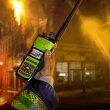A watchful eye
On Jan. 24, President-elect Barack Obama stood behind a podium at the National Mall in Washington, D.C., his hand on a Bible, swearing to protect the interests of the American public. In the background, first-responder agencies stood ready with a toolbox of technologies to keep a close eye on the public — and the president — in case anyone threatened to disrupt the historic 2009 inauguration.
For example, the Washington, D.C., Office of the Chief Technology Officer (OCTO) turned to Federal Signal Corp. to develop a customized alerting system that featured digital speaker arrays, intelligent command and control software, a voice controller, IP-based cameras and wireless capabilities to support security operations surrounding the event, said Michael Wons, the company’s vice president of public safety systems.
“If a situation occurred, public-safety officials could use the [alerting] system to send tone alerts, as well as voice notification to people in the event of an evacuation as the event was unfolding,” Wons said.
The company installed the speaker arrays throughout the D.C. area. The speaker arrays would have released tone and voice instructions to evacuate inauguration attendees in the event of an emergency, Wons said. Other technologies were installed throughout the area, but security reasons restricted the company from providing additional details, he said.
To support field officers, the company deployed two 55-foot-long, self-standing trailers that acted as wireless hot spots. Each trailer was powered by a 7-kilowatt diesel generator and included a 50-foot tower. Inside, it housed multiple technologies, including mobile routers and other systems that supported 4.9 GHz and 2.4 GHz hotspots. In addition, the system used 3G commercial cellular as a backup to send video feeds to the trailers and the OCTO command center, Wons said.
Wons said it was challenging to interoperate with existing networks, because his team had to conquer multiple firewalls across entities while deciphering the different ways each public-safety agency manages its network. He said it is tough to access the correct portals, to make connections and to ensure the security features work across such networks.
“We had to have a secure end to leverage the existing network and stream the data real-time,” he said. “So we used our interoperable communication platform that allows any device to communicate across any kind of network medium, such as UHF, VHF, cellular or VoIP.”
It also was a challenge to access secure government buildings around the inauguration, such as the FBI building. For the system to work, infrastructure like broadband wireless routers, antennas and the speaker array needed to be installed on the rooftops, as well as along the parade route. Wons said the company had to work with the FBI and government agencies to access rooftops and other areas around the parade route — both public and private — to mount systems.
“We needed to be strategic where we placed the arrays down Pennsylvania Avenue, too, and where we could tap into power and mount systems,” he said.
Each trailer cost $45,000 to $50,000, which included the requested technologies as well as tapping into the 3G network, Wons said.
Area dispatchers also prepared for an increase in 911 calls due to the inauguration and associated events. To gear up, personnel of the Office of Unified Communications (OUC) — which dispatches for the Metropolitan Police Department and the Fire and Emergency Medical Services (FEMS), as well as other Washington public-service agencies — used Intergraph‘s public safety computer-aided dispatch system to route emergency calls received from the district, said Stephen Williams, the company’s resident engineer.
During the inauguration, the OUC dispatched its Unified Communications Center and a redundant back-up facility, the Public Safety Communications Center. After the Secret Service contacted the OUC with details of road closures and other security measures, Williams said the CAD system was programmed to create a special event zone around the plaza, parade route and other designated event areas. The area, dubbed the Green Zone, is a 3-mile area around the National Mall where the president-elect, other government officials and the public gathered for the inauguration.
Inside the zone, the CAD system was deployed in remote command posts staffed by dispatchers. It also was deployed at in-zone command posts for police, fire, and a joint operations center staffed by about 50 area agencies, including the Secret Service, FBI, Capital Police and the Department of Public Works, Williams said.
“We were able to leverage the CAD system by setting up a satellite location inside the Green Zone that was staffed by dispatchers,” Williams said. “When a 911 call would come in from the zone it would be routed to those dispatchers who would dispatch resources located inside the zone.”
In addition, Williams said they also programmed the CAD system to cut off the Green Zone, forcing the system to intelligently recognize that it couldn’t send local first-responder resources through that area.
“Using the system, a unit would instantly be re-routed to an alternative route to reach a location,” he said.
Multiband radios also were used to support inauguration activities, said Stephen Nichols, Thales‘ director of business development for public safety. He said the company’s Liberty, multimode, multiband radio has been tested by the Department of Defense for nearly 10 years. Last year, a public-safety version was unveiled at the International Wireless Communications Exposition in Las Vegas. The company saw the inauguration as an opportunity to test the radio on the ground during a large-scale, planned event.
The $5,000 Liberty lets first responders communicate across multiple bands over analog and digital trunking systems, said Scott Glazer, applications specialist and Thales’ man on the ground during the inauguration. He said the company networked with Washington-area first responders and asked if the radio could be beta-tested during inauguration operations.
“It wasn’t just a test of our radio, but multiband radios in general for use by the public-safety sector,” he said.
Ten multiband radios were deployed and put in the hands of senior command staff. Glazer said the radios were deployed to several locations and area commands for fire, rescue and EMS departments that were responsible for responding to incidents at the National Mall. Radios also were deployed to the District of Columbia fire command post and an another operational staging area in neighboring Montgomery County where additional backup resources were staged “in case a large event happened,” he said.
The radios were programmed across multiple channels and bands that let field personnel monitor communications between disparate agencies. For example, 150 EMS units were deployed throughout the district, including units from agencies in neighboring Maryland and Virginia, as well as privately contracted ambulance companies — all of which operated on disparate systems.
“Everyone’s on different channels, so the multiband radio allowed them to monitor different groups that were moving in and out of the area without having to carry three or four different radios to coordinate resources,” Glazer said. “We didn’t have it deployed as their primary radio system, but their job was to monitor everything that was going on and the radio made it easy for them to do this.”
Unique was the ability to test the radios during a planned, large-scale event. Unlike a natural disaster where responders are focused on the incident, a planned event gave first-responders time to test the radio and provide accurate feedback on how it worked. Glazer said first-responders testing the radios commented that there is an absolute need for multiband radios to make their job easier and interface with more agencies.
“We had positive feedback about the radio, and we are still getting more feedback forms coming in from users in the field,” he said.
Related Stories













